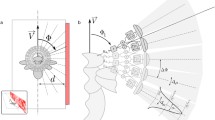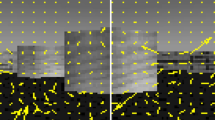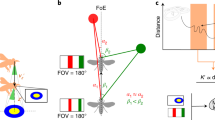Abstract
Some insects use optic flow (OF) to perform their navigational tasks perfectly. Learning from insects’ OF navigation strategies, this article proposes a bio-inspired integrated navigation system based on OF. The integrated navigation system is composed of an OF navigation system (OFNS) and an OF aided navigation system (OFAN). The OFNS uses a simple OF method to measure motion at each step along a path. The position information is then obtained by path integration. However, path integration leads to cumulative position errors which increase rapidly with time. To overcome this problem, the OFAN is employed to assist the OFNS in estimating and correcting these cumulative errors. The OFAN adopts an OF-based Kalman filter (KF) to continuously estimate the position errors. Moreover, based on the OF technique used in the OFNS, we develop a new OF method employed by the OFAN to generate the measurement input of the OF-based KF. As a result, both the OFNS and the OFAN in our integrated navigation system are derived from the same OF method so that they share input signals and some operations. The proposed integrated navigation system can provide accurate position information without interference from cumulative errors yet doing so with low computational effort. Simulations and comparisons have demonstrated its efficiency.
Similar content being viewed by others
References
Baird E, Srinivasan MV, Zhang SW, Cowling A (2005) Visual control of flight speed in honeybees. J Exp Bio 208: 3895–3905
Boeddeker N, Dittmar L, Stürzl W, Egelhaaf M (2010) The fine structure of honeybee head and body yaw movements in a homing task. Proc Biol Sci 277: 1899–1906
Cartwright BA, Collett TS (1987) Landmark Maps for Honeybees. Biol Cybern 57: 85–93
Chahl JS, Srinivasan MV (1996) Visual computation of egomotion using an image interpolation technique. Biol Cybern 74: 405–411
Cheung A, Zhang SW, Stricker C, Srinivasan MV (2008) Animal navigation: general properties of directed walks. Biol Cybern 99: 197–217
Cho HJ, Park TH (2010) Wavelet transform based image template matching for automatic component inspection. Int J Adv Manuf Technol 50: 1033–1039
Collett TS, Rees JA (1997) View-based navigation in Hymenoptera: multiple strategies of landmark guidance in the approach to a feeder. J Comp Physiol A 181: 47–58
Dittmar L, Sturzl W, Baird E, Boeddeker N, Egelhaaf M (2010) Goal seeking in honeybees: matching of optic flow snapshots. J Exp Biol 213: 2913–2923
Franceschini N (2004) Visual guidance based on optic flow: A biorobotic approach. J Physiol Paris 98: 281–292
Harris RA, O’Carrol DC (2002) Afterimages in fly motion vision. Vision Res 42: 1701–1714
Hostetler LD, Andreas RD (1983) Nonlinear Kalman filtering techniques for terrain-aided navigation. IEEE Trans Autom Control 28(3): 315–323
Kim J, Sukkarieh S (2004) Autonomous airborne navigation in unknown terrain environments. IEEE Trans Aerosp Electron Sys 40(3): 1031–1045
Lambrinos D, Moller R, Labhart T, Pfeifer P, Wehner R (2000) A mobile robot employing insect strategies for navigation. Robotics Auton Sys 30: 39–64
Manchester IR, Savkin AV, Faruqi FA (2003) Optical-flow based Precision Missile Guidance inspired by honeybee navigation. In: Proceedings of the 42nd IEEE conference on decision and control, Maui, pp 5444–5449
Muratet L, Doncieux S, Meyer JA (2005) A biomimetic reactive navigation system using the optical flow for a rotary-wing UAV in urban environment. Robotics Auton Sys 50: 195–209
Nagle MG, Srinivasan MV, Wilson DL (1997) Image interpolation technique for measurement of egomotion in 6 degrees of freedom. J Opt Soc Am A 14(12): 3233–3241
Ronacher B, Wehner R (1995) Desert ants cataglyphis fortis use self-induced optic flow to measure distances travelled. J Comp Physiol A 177: 21–27
Ruffier F, Franceschini N (2005) Optic flow regulation: the key to aircraft automatic guidance. Robotics Auton Sys 50: 177–194
Sim DG, Park RH, Kim RC, Lee SU, Kim IC (2002) Integrated position estimation using aerial image sequences. IEEE Trans Pattern Anal Mach Intell 24(1): 1–18
Srinivasan MV (1994) An image-interpolation technique for the computation of OF and egomotion. Biol Cybern 71: 401–415
Srinivasan MV, Zhang SW, Bidwell NJ (1997) Visual mediated odometry in honeybees. J Exp Biol 200: 2513–2522
Srinivasan MV, Zhang SW, Altwein M, Tautz J (2000) Honeybee navigation: nature and calibration of the ’Odometer’. Science 287: 851–853
Zufferey JC, Floreano D (2006) Fly-inspired viaual steering of an ultralight indoor aircraft. IEEE Trans Robotics 22(1): 137–146
Author information
Authors and Affiliations
Corresponding author
Rights and permissions
About this article
Cite this article
Pan, C., Deng, H., Yin, X.F. et al. An optical flow-based integrated navigation system inspired by insect vision. Biol Cybern 105, 239–252 (2011). https://doi.org/10.1007/s00422-011-0463-5
Received:
Accepted:
Published:
Issue Date:
DOI: https://doi.org/10.1007/s00422-011-0463-5




